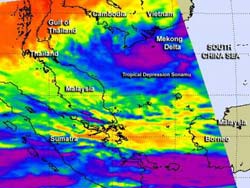NASA watches a slow-moving Tropical Depression Sonamu

This AIRS infrared image of Tropical Depression Sonamu on Jan. 8 at 1:41 a.m. EST, showed some very cold cloud top temperatures (purple) of -63F (-52C) existed, indicating there was still some strong convection occurring.<br><br>Credit: NASA JPL, Ed Olsen<br>
When NASA's Aqua satellite passed over Tropical Depression Sonamu on Jan. 8 at 0641 UTC (1:41 a.m. EST/U.S.), the Atmospheric Infrared Sounder (AIRS) instrument aboard took an infrared look at the storm.
AIRS data showed that Sonamu still contained some very cold cloud top temperatures of -63F (-52C) indicating there was still some strong convection occurring near the center of circulation. The strongest storms were located southwest of the Mekong Delta at the time of the satellite image.
Multispectral satellite imagery showed that the low level circulation center was exposed to outside winds, and that the center was disorganized.
By 1500 UTC (10 a.m. EST/U.S.), Sonamu's maximum sustained winds were near 30 knots (34.5 mph/55.5 kph). Sonamu was centered near 5.3 north latitude and 109.3 east longitude, about 335 nautical miles (385.5 miles/620.4 km) west of Brunei. It was drifting to the southeast at 3 knots (3.4 mph/5.5 kph).
Sonamu is expected to continue its slow movement to the southeast and weaken further as wind shear increases. The Joint Typhoon Warning Center expects that Sonamu will make a landfall sometime on Jan. 10 in the Malaysian part of Borneo.
Media Contact
More Information:
http://www.nasa.govAll latest news from the category: Earth Sciences
Earth Sciences (also referred to as Geosciences), which deals with basic issues surrounding our planet, plays a vital role in the area of energy and raw materials supply.
Earth Sciences comprises subjects such as geology, geography, geological informatics, paleontology, mineralogy, petrography, crystallography, geophysics, geodesy, glaciology, cartography, photogrammetry, meteorology and seismology, early-warning systems, earthquake research and polar research.
Newest articles

A universal framework for spatial biology
SpatialData is a freely accessible tool to unify and integrate data from different omics technologies accounting for spatial information, which can provide holistic insights into health and disease. Biological processes…

How complex biological processes arise
A $20 million grant from the U.S. National Science Foundation (NSF) will support the establishment and operation of the National Synthesis Center for Emergence in the Molecular and Cellular Sciences (NCEMS) at…

Airborne single-photon lidar system achieves high-resolution 3D imaging
Compact, low-power system opens doors for photon-efficient drone and satellite-based environmental monitoring and mapping. Researchers have developed a compact and lightweight single-photon airborne lidar system that can acquire high-resolution 3D…





















